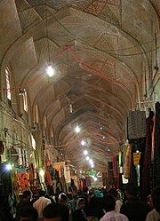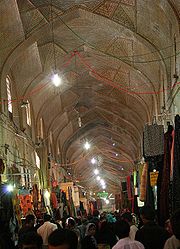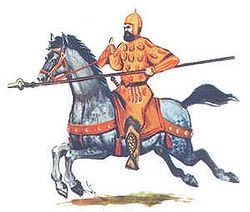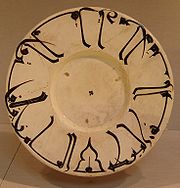
Buwayhid
Encyclopedia
The Buyid dynasty, also known as the Buyid Empire or the Buyids ( Āl-e Buye), also known as Buwaihids, Buyahids, or Buyyids, were a Shī‘ah Persian
dynasty that originated from Daylaman in Gilan. They founded a confederation that controlled most of modern-day Iran
and Iraq
in the 10th and 11th centuries.
 The founders of the Būyid confederation were ‘Alī ibn Būyah
The founders of the Būyid confederation were ‘Alī ibn Būyah
and his two younger brothers, al-Hassan
and Aḥmad
. Originally a soldier in the service of the Ziyārīds of Ṭabaristān, ‘Alī was able to recruit an army to defeat a Turkish general from Baghdad
named Yāqūt in 934. Over the next nine years the three brothers gained control of the remainder of the 'Abbāsid Caliphate
. While they accepted the titular authority of the caliph in Baghdad, the Būyid rulers assumed effective control of the state.
The first several decades of the Būyid confederation were characterized by large territorial gains. In addition to Fars and Jibal
, which were conquered in the 930s, and central Iraq, which submitted in 945, the Būyids took Kermān
(967), Oman
(967), the Jazīra (979), Ṭabaristān (980), and Gorgan
(981). After this, however, the Būyids went into a slow decline, with pieces of the confederation gradually breaking off and local dynasties under their rule becoming de facto independent.
The approximate century of Būyid rule, coupled with the rise of other Iranian dynasties in the region, represents a period in Iranian history sometimes called the 'Iranian Intermezzo
' since it was an interlude between the rule of the 'Abbāsid Arabs and the Seljuq Turks. Indeed, as Dailamite Iranians the Būyids consciously revived symbols and practices of Persia's Sassānid dynasty. In fact, beginning with 'Adud al-Dawla they used the ancient Sassānid title Shāhanshāh , literally "king of kings".
The Buyid confederation was split between and governed by multiple members of the dynasty. They nominally recognized the suzerainty of caliphs of Baghdad, who in reality had no temporal power within the state. The title used by the Buyid rulers was amīr, meaning "governor" or "prince". Generally one of the amīrs would be recognized as having seniority over the others; this individual would use the title of amīr al-umarā, or senior amīr. Although the senior amīr was the formal head of the Būyids, he did not usually have any significant control outside of his own personal amirate; each amir enjoyed a high degree of autonomy within his own territories. As mentioned above, some of the stronger amīrs used the Sassānid title of Shāhanshāh. Succession of power was hereditary
, with fathers dividing their land among their sons.
 The Būyid army consisted of their fellow Dailamite Iranians, who served as foot soldiers, and of the Turkish cavalry that had played a prominent role in the 'Abbāsid military. The Dailamites and Turks often quarreled with each other in an attempt to be the dominant force within the army. To compensate their soldiers the Būyid amīrs often distributed iqtās, or the rights to a percentage of tax revenues from a province, although the practice of payment in kind
The Būyid army consisted of their fellow Dailamite Iranians, who served as foot soldiers, and of the Turkish cavalry that had played a prominent role in the 'Abbāsid military. The Dailamites and Turks often quarreled with each other in an attempt to be the dominant force within the army. To compensate their soldiers the Būyid amīrs often distributed iqtās, or the rights to a percentage of tax revenues from a province, although the practice of payment in kind
was also frequently used.
Like most Daylamites at the time, the Būyids were originally Zaydī or Fiver Shī'as. After taking power in Iran and Iraq, however, they began to lean closer to Twelver Shī'ism, possibly due to political considerations. In fact, the Būyids rarely attempted to enforce a particular religious view upon their subjects except when in matters where it would be politically expedient. The Sunnī 'Abbāsids retained the caliphate, although they were deprived of all secular power. In addition, in order to prevent tensions between the Shī'a and Sunni from spreading to government agencies, the Būyid amirs occasionally appointed Christians to high offices instead of Muslims from either sect.
, the first Shia Imam, Zaydis Shi'ism doctrine would have urged them to install an Imam from Ali's family. For that reason Buyids tended toward Twelver Shia' which its occulted Imam
was more politically attractive to them.
and Iraq
. Sometimes a ruler would come to rule more than one region, but no Buyid rulers ever exercised direct control of all three regions.
Daylamids of Fars
Power in Fars seized by the Shabankara
Kurdish
Chief Fadluya
 Daylamids of Rey
Daylamids of Rey
To the Ghaznavids.
Daylamids of Iraq
To the Seljuqs.
Buyids of Basra
To the Buyids of Fars.
Buyids of Hamadan
To the Kakuyids
.
Buyids of Kerman
To the Buyids of Fars.
Buyids of Khuzistan
To the Buyids of Fars.
[6] The Buyid Domination as the Historical Background for the Flourishing of Muslim Scholarship During the 4th/10th Century by Dr. M. Ismail Marcinkowski*
Persian people
The Persian people are part of the Iranian peoples who speak the modern Persian language and closely akin Iranian dialects and languages. The origin of the ethnic Iranian/Persian peoples are traced to the Ancient Iranian peoples, who were part of the ancient Indo-Iranians and themselves part of...
dynasty that originated from Daylaman in Gilan. They founded a confederation that controlled most of modern-day Iran
Iran
Iran , officially the Islamic Republic of Iran , is a country in Southern and Western Asia. The name "Iran" has been in use natively since the Sassanian era and came into use internationally in 1935, before which the country was known to the Western world as Persia...
and Iraq
Iraq
Iraq ; officially the Republic of Iraq is a country in Western Asia spanning most of the northwestern end of the Zagros mountain range, the eastern part of the Syrian Desert and the northern part of the Arabian Desert....
in the 10th and 11th centuries.
History

'Imad al-Daula
Ali ibn Buya "'Imad al-Daula" was the founder of the Buyid dynasty in Iran .- Early career :'Ali first entered the services of the Samanids under Nasr II, where he became a member of the ruler's entourage. From there he eventually joined Makan, who ruled Gorgan and Ray as a governor of the...
and his two younger brothers, al-Hassan
Rukn al-Daula
Hasan , known as Rukn al-Dawla, was the first Buyid amir of northern and central Iran . He was the son of Buya.-Struggle for power:...
and Aḥmad
Mu'izz al-Daula
Ahmad was the first of the Buwayhid emirs of Iraq, ruling from 945 until his death. He was the son of Buya.During the Buwayhid conquest of Fars, Ahmad distinguished himself in battle. In 935 or 936, Ahmad's oldest brother 'Ali sent Ahmad to Kerman with the task of conquering that province from the...
. Originally a soldier in the service of the Ziyārīds of Ṭabaristān, ‘Alī was able to recruit an army to defeat a Turkish general from Baghdad
Baghdad
Baghdad is the capital of Iraq, as well as the coterminous Baghdad Governorate. The population of Baghdad in 2011 is approximately 7,216,040...
named Yāqūt in 934. Over the next nine years the three brothers gained control of the remainder of the 'Abbāsid Caliphate
Abbasid
The Abbasid Caliphate or, more simply, the Abbasids , was the third of the Islamic caliphates. It was ruled by the Abbasid dynasty of caliphs, who built their capital in Baghdad after overthrowing the Umayyad caliphate from all but the al-Andalus region....
. While they accepted the titular authority of the caliph in Baghdad, the Būyid rulers assumed effective control of the state.
The first several decades of the Būyid confederation were characterized by large territorial gains. In addition to Fars and Jibal
Jibal
Jibāl was a short-lived Arab-ruled province located in western Iran, under the Abbasid Caliphate of Baghdad. It was roughly coterminous with the ancient country of the Medes. In 10th century it came back under Persian rule ....
, which were conquered in the 930s, and central Iraq, which submitted in 945, the Būyids took Kermān
Kerman
- Geological characteristics :For the Iranian paleontologists, Kerman has always been considered a fossil paradise. Finding new dinosaur footprints in 2005 has now revealed new hopes for paleontologists to better understand the history of this area.- Economy :...
(967), Oman
Oman
Oman , officially called the Sultanate of Oman , is an Arab state in southwest Asia on the southeast coast of the Arabian Peninsula. It is bordered by the United Arab Emirates to the northwest, Saudi Arabia to the west, and Yemen to the southwest. The coast is formed by the Arabian Sea on the...
(967), the Jazīra (979), Ṭabaristān (980), and Gorgan
Gorgan
Gorgan Some east of Gorgan is the Golestan National Park. The city has a regional airport and several universities. Gorgan Airport was opened in September 2005.-Etymology:...
(981). After this, however, the Būyids went into a slow decline, with pieces of the confederation gradually breaking off and local dynasties under their rule becoming de facto independent.
The approximate century of Būyid rule, coupled with the rise of other Iranian dynasties in the region, represents a period in Iranian history sometimes called the 'Iranian Intermezzo
Iranian Intermezzo
The term Iranian Intermezzo represents a period in Middle Eastern history which saw the rise of various native Iranian Muslim dynasties on the Iranian Plateau. This term is noteworthy since it was an interlude between the decline of Abbāsid Arab rule and power and the eventual emergence of the...
' since it was an interlude between the rule of the 'Abbāsid Arabs and the Seljuq Turks. Indeed, as Dailamite Iranians the Būyids consciously revived symbols and practices of Persia's Sassānid dynasty. In fact, beginning with 'Adud al-Dawla they used the ancient Sassānid title Shāhanshāh , literally "king of kings".
The Buyid confederation was split between and governed by multiple members of the dynasty. They nominally recognized the suzerainty of caliphs of Baghdad, who in reality had no temporal power within the state. The title used by the Buyid rulers was amīr, meaning "governor" or "prince". Generally one of the amīrs would be recognized as having seniority over the others; this individual would use the title of amīr al-umarā, or senior amīr. Although the senior amīr was the formal head of the Būyids, he did not usually have any significant control outside of his own personal amirate; each amir enjoyed a high degree of autonomy within his own territories. As mentioned above, some of the stronger amīrs used the Sassānid title of Shāhanshāh. Succession of power was hereditary
Heredity
Heredity is the passing of traits to offspring . This is the process by which an offspring cell or organism acquires or becomes predisposed to the characteristics of its parent cell or organism. Through heredity, variations exhibited by individuals can accumulate and cause some species to evolve...
, with fathers dividing their land among their sons.

Payment in kind
Payment in kind refers to payment for goods or services with a medium other than legal tender ....
was also frequently used.
Like most Daylamites at the time, the Būyids were originally Zaydī or Fiver Shī'as. After taking power in Iran and Iraq, however, they began to lean closer to Twelver Shī'ism, possibly due to political considerations. In fact, the Būyids rarely attempted to enforce a particular religious view upon their subjects except when in matters where it would be politically expedient. The Sunnī 'Abbāsids retained the caliphate, although they were deprived of all secular power. In addition, in order to prevent tensions between the Shī'a and Sunni from spreading to government agencies, the Būyid amirs occasionally appointed Christians to high offices instead of Muslims from either sect.
The Fall
During the mid-11th century, the Buyid amirates gradually fell to the Ghaznavid and Seljuq Turks. In 1055, Tughrul conquered Baghdad, the seat of the caliphate, and ousted the last of the Buyid rulers. Like the Buyids, the Seljuqs kept the Abbasid caliphate as the titular ruler.Religion
Buyids were Shia and have been called Twelver Shia. However, it is more likely that began as Zaydi Shia'. As the reason of this turning from Zaydis to Twelver Moojen Momen suggests that since the Buyids were not descendants of AliAli
' |Ramaḍān]], 40 AH; approximately October 23, 598 or 600 or March 17, 599 – January 27, 661).His father's name was Abu Talib. Ali was also the cousin and son-in-law of the Islamic prophet Muhammad, and ruled over the Islamic Caliphate from 656 to 661, and was the first male convert to Islam...
, the first Shia Imam, Zaydis Shi'ism doctrine would have urged them to install an Imam from Ali's family. For that reason Buyids tended toward Twelver Shia' which its occulted Imam
Muhammad al-Mahdi
Muḥammad ibn al-Ḥasan al-Mahdī is believed by Twelver Shī‘a Muslims to be the Mahdī, an ultimate savior of humankind and the final Imām of the Twelve Imams...
was more politically attractive to them.
Major rulers
Generally, the three most powerful Buyid amirs at any given time were those in control of Fars, JibalJibal
Jibāl was a short-lived Arab-ruled province located in western Iran, under the Abbasid Caliphate of Baghdad. It was roughly coterminous with the ancient country of the Medes. In 10th century it came back under Persian rule ....
and Iraq
Iraq
Iraq ; officially the Republic of Iraq is a country in Western Asia spanning most of the northwestern end of the Zagros mountain range, the eastern part of the Syrian Desert and the northern part of the Arabian Desert....
. Sometimes a ruler would come to rule more than one region, but no Buyid rulers ever exercised direct control of all three regions.
Daylamids of Fars
- Ali b. Buya ('Imad ad-Dawla)'Imad al-DaulaAli ibn Buya "'Imad al-Daula" was the founder of the Buyid dynasty in Iran .- Early career :'Ali first entered the services of the Samanids under Nasr II, where he became a member of the ruler's entourage. From there he eventually joined Makan, who ruled Gorgan and Ray as a governor of the...
934-949 - Fana Khusraw ('Adud ad-Dawla)'Adud al-DaulaAḍud al-Dawla or Azod od-Dowleh Panah Khusraw was an emir of the Buyid dynasty in Iran and Iraq...
949-983 - Shirzil b. Fana Khusraw (Sharaf ad-Dawla)Sharaf al-DaulaShirdil Abu'l-Fawaris was the Buyid amir of Kerman and Fars , as well as Iraq . He was the eldest son of 'Adud al-Daula....
983-989 - Marzuban b. Fana Khusraw (Samsam ad-Dawla)Samsam al-DaulaAbu Kalijar Marzuban aka Samsam al-Daula was the Buyid amir of Iraq , as well as Fars and Kerman . He was the second son of 'Adud al-Daula.The Abbasaid recognized his succession and conferred upon him the title Samsam Al-Daula. Samsam's rule lasted for barely four years...
989-998 - Firuz b. Fana Khusraw (Baha' ad-Dawla)Baha' al-DaulaBaha' al-Daula was the Buyid amir of Iraq , along with Fars and Kerman . He was the third son of 'Adud al-Daula....
998-1012 - Abu Shuja' b. Firuz (Sultan ad-Dawla)Sultan al-DaulaAbu Shuja was the Buyid amir of Fars and Iraq . He was the son of Baha' al-Daula.Abu Shuja lived in Baghdad during his youth. Shortly before Baha' al-Daula's death, he named Abu Shuja as his successor. Upon succeeding his father, he took the title "Sultan al-Daula wa 'Izz al-Milla"...
1012-1024 - Abu Kalijar Marzuban b. Abu Shuja' (Imad al-Din)Abu KalijarAbu Kalijar was the Buyid amir of Fars , Kerman and Iraq . He was the eldest son of Sultan al-Daula....
1024-1048 - Abu Mansur Fulad SutunAbu Mansur Fulad SutunAbu Mansur Fulad Sutun was the Buyid amir of Fars, ruling more or less continuously from 1048 until his death. He was the son of Abu Kalijar....
1048-1062
Power in Fars seized by the Shabankara
Shabankara
Shabankareh was the name of an ancient tribal federation in the southern Zagros...
Kurdish
Kurdish people
The Kurdish people, or Kurds , are an Iranian people native to the Middle East, mostly inhabiting a region known as Kurdistan, which includes adjacent parts of Iran, Iraq, Syria, and Turkey...
Chief Fadluya

Ray, Iran
Rey or Ray , also known as Rhages and formerly as Arsacia, is the capital of Rey County, Tehran Province, Iran, and is the oldest existing city in the province....
- Rukn ad-DawlaRukn al-DaulaHasan , known as Rukn al-Dawla, was the first Buyid amir of northern and central Iran . He was the son of Buya.-Struggle for power:...
935-976 - Fakhr ad-DawlaFakhr al-DaulaFakhr al-Dawla was the Buyid amir of Jibal , Hamadan and Gurgan and Tabaristan . He was the second son of Rukn al-Daula.-Rise to power and deposition:...
976-980 - Mu'ayyed ad-DawlaMu'ayyad al-DaulaMu'ayyad al-Daula was the Buyid amir of Hamadan , Jibal , Tabaristan , and Gorgan . He was the third son of Rukn al-Daula....
980-983 - Fakhr ad-Dawla (restored) 984-997
- Majd ad-DawlaMajd al-DaulaAbu Taleb Rostam, known as Majd al-Dawla, was the Buyid emir of Rayy, a city in Iran . He was the eldest son of Fakhr al-Daula. His reign saw the removal of the Buyids as a power in central Iran....
997-1029
To the Ghaznavids.
Daylamids of Iraq
- Mu'izz ad-DawlaMu'izz al-DaulaAhmad was the first of the Buwayhid emirs of Iraq, ruling from 945 until his death. He was the son of Buya.During the Buwayhid conquest of Fars, Ahmad distinguished himself in battle. In 935 or 936, Ahmad's oldest brother 'Ali sent Ahmad to Kerman with the task of conquering that province from the...
945-967 - 'Izz ad-Dawla'Izz al-DaulaIzz al-Daula was the Buyid amir of Iraq . He was born Bakhtiyar, and was the son of Mu'izz al-Daula.In the spring of 955, Mu'izz al-Daula became very ill and decided to name his son as his successor. Five years later, the caliph officially recognized this by granting Bakhtiyar the title of "'Izz...
966-978 - 'Adud ad-Dawla'Adud al-DaulaAḍud al-Dawla or Azod od-Dowleh Panah Khusraw was an emir of the Buyid dynasty in Iran and Iraq...
978-983 - Samsam ad-DawlaSamsam al-DaulaAbu Kalijar Marzuban aka Samsam al-Daula was the Buyid amir of Iraq , as well as Fars and Kerman . He was the second son of 'Adud al-Daula.The Abbasaid recognized his succession and conferred upon him the title Samsam Al-Daula. Samsam's rule lasted for barely four years...
983-987 - Sharaf ad-DawlaSharaf al-DaulaShirdil Abu'l-Fawaris was the Buyid amir of Kerman and Fars , as well as Iraq . He was the eldest son of 'Adud al-Daula....
987-989 - Baha' ad-DawlaBaha' al-DaulaBaha' al-Daula was the Buyid amir of Iraq , along with Fars and Kerman . He was the third son of 'Adud al-Daula....
989-1012 - Sultan ad-DawlaSultan al-DaulaAbu Shuja was the Buyid amir of Fars and Iraq . He was the son of Baha' al-Daula.Abu Shuja lived in Baghdad during his youth. Shortly before Baha' al-Daula's death, he named Abu Shuja as his successor. Upon succeeding his father, he took the title "Sultan al-Daula wa 'Izz al-Milla"...
1012-1021 - Musharrif ad-DawlaMusharrif al-DaulaAbu 'Ali was the Buyid amir of Iraq . He was the youngest son of Baha' al-Daula.In 1021 the Turkish establishment in Baghdad, which had become upset over the influence of amir Sultan al-Daula's Daliam troops, raised Abu 'Ali to power. Given the title "Musharrif al-Daula", he decided to negotiate...
1021-1025 - Jalal ad-DawlaJalal al-DaulaAbu Tahir Jalal al-Daula was the Buyid amir of Iraq . He was the son of Baha' al-Daula.In 1012 Jalal al-Daula's father died. His brother, Sultan al-Daula came to the throne and appointed him as governor of Basra. He ruled there up until Musharrif al-Daula, who had taken control of Iraq, died in...
1025-1044 - Abu KalijarAbu KalijarAbu Kalijar was the Buyid amir of Fars , Kerman and Iraq . He was the eldest son of Sultan al-Daula....
1044-1048 - al-Malik ar-RahimAl-Malik al-RahimAbu Nasr Khusrau Firuz was the Buyid amir of Iraq . He was the son of Abu Kalijar.Upon his father's death, he took the throne in Baghdad with the title "al-Malik al-Rahim". His succession to the entire Buyid Empire was prevented by his brother Abu Mansur Fulad Sutun, who took control of Fars. The...
1048-1055
To the Seljuqs.
Minor rulers
It was not uncommon for younger sons to found collateral lines, or for individual Buyid members to take control of a province and begin ruling there. The following list is incomplete.Buyids of Basra
- Diya' al-DaulaDiya' al-DaulaDiya' al-Daula was the Buyid ruler of Basra during the 980s. He was the son of 'Adud al-Daula.- History :Following 'Adud al-Daula's death in 983, his possessions were divided between his sons. Samsam al-Daula, who was the presumed successor of 'Adud al-Daula, took power, but Sharaf al-Daula took...
980s
To the Buyids of Fars.
Buyids of Hamadan
- Mu'ayyad al-DaulaMu'ayyad al-DaulaMu'ayyad al-Daula was the Buyid amir of Hamadan , Jibal , Tabaristan , and Gorgan . He was the third son of Rukn al-Daula....
976-983 - Shams al-DaulaShams al-DaulaAbu Taher was the Buyid ruler of Hamadan from 997 to 1021. He was the son of Fakhr al-Daula.Fakhr al-Daula died in 997; his elder son Abu Taleb Rostam took power in the bulk of his father's possessions in Jibal. Abu Taher himself gained the governorships of Hamadan and Kirmanshah, and was hence...
997-1021 - Sama' al-DaulaSama' al-DaulaSama' al-Daula was the Buyid ruler of Hamadan . He was the son of Shams al-Daula.Upon his father's death, Sama' al-Daula succeeded him to the governorship of that province. Only after a short reign, however, the Kakuyids of Isfahan overran Hamadan and ended Sama' al-Daula's rule.-References:* R. N....
1021-1024
To the Kakuyids
Kakuyids
The Kakūyids were a Daylamite dynasty that held power in Isfahān . They were also the ātābegs of Yazd and Abarkūh from c...
.
Buyids of Kerman
- Qawam al-DaulaQawam al-DaulaAbu'l-Fawaris was the Buyid ruler of Kerman . He was the son of Baha' al-Daula.When Abu'l-Fawaris' brother Sultan al-Daula became the senior amir of the Buyids in 1012, he appointed Abu'l-Fawaris as governor of Kerman...
1012-1028
To the Buyids of Fars.
Buyids of Khuzistan
- Taj al-DaulaTaj al-DaulaTaj al-Daula was the Buyid ruler of Khuzestan during the 980s. He was the son of 'Adud al-Daula.Following 'Adud al-Daula's death in 983, his possessions were divided between his sons. Samsam al-Daula, who was the presumed successor of 'Adud al-Daula, took power, but Sharaf al-Daula took advantage...
980s
To the Buyids of Fars.
Family tree
See also
- Full list of Iranian Kingdoms
- Persian Empire
- List of Shi'a Muslims dynasties
[6] The Buyid Domination as the Historical Background for the Flourishing of Muslim Scholarship During the 4th/10th Century by Dr. M. Ismail Marcinkowski*
External links
- Encyclopedia Iranica "Buyids" Tilman Nagel
- Encyclopedia Iranica: DEYLAMITES
- http://buali.ir/PDF/121%20Marcinkowski-FULL%20TEXT%20PAPER.pdf The Buyid Domination as the Historical Background for the Flourishing of Muslim Scholarship During the 4th/10th Century by Dr. M. Ismail Marcinkowski
- The Buwaihids in Iran and Iraq

